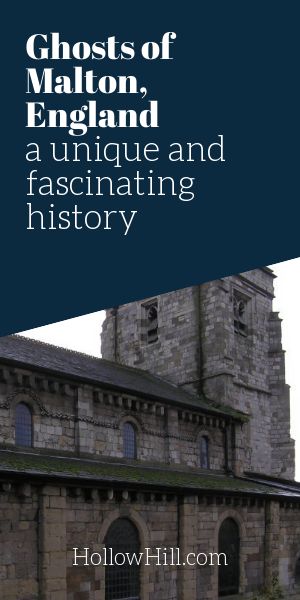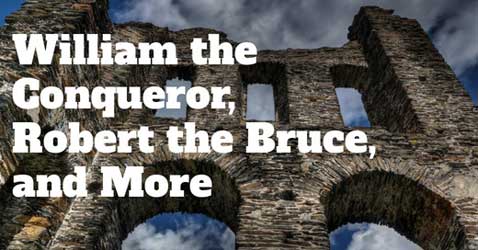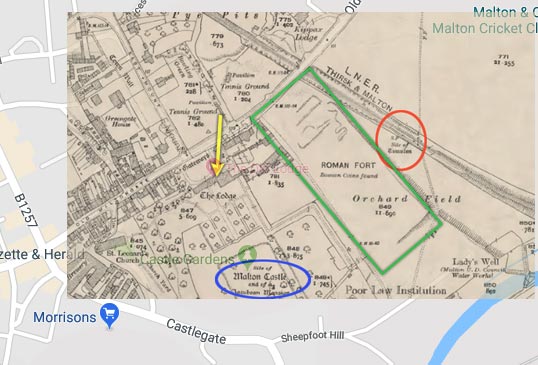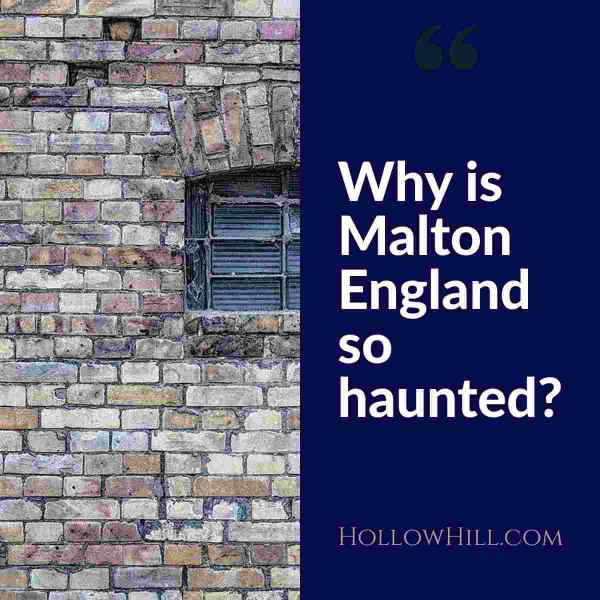As an Amazon Associate I earn from qualifying purchases. Click for details.
Malton is one of England’s most fascinating haunts, and it’s an ideal destination if you’re ghost hunting. Malton’s history can make your ghost vigils even more interesting.
For starters, Eden Camp – featured on “Most Haunted” – is just one of many ghostly sites you can investigate around Malton, England.
But, as they say, that’s the tip of the iceberg.
Let’s start with the A64, where you might glimpse a ghost and not even realize it.
Ghosts of Malton, England
 The A64’s ghost story is from the late 18th century or early 19th century, when a woman – traveling along the old Roman road – may have been murdered by a highwayman.
The A64’s ghost story is from the late 18th century or early 19th century, when a woman – traveling along the old Roman road – may have been murdered by a highwayman.
She is seen on foggy or misty nights, traveling towards Malton. She wears a simple, traditional gown – not torn or bloody, just normal-looking for that era – and she’s carrying a child.
The ghostly woman glances towards passing cars, but doesn’t seem to see them. She just keeps walking.
The odd thing is, despite her apparently rapid pace, she’s not making much progress. It’s as if she’s suspended just slightly over the ground, and walking towards the town.
If you’re on the A64 en route Malton for ghost hunting, watch for her. Your search for ghosts may be successful, even sooner than you’d expected.
The Talbot Hotel in Malton may have a ghost in its cloisters area. At the very least, several people have reported cold spots. (Later in this article, you’ll read why this hotel might have some wonderful residual energy. Expect ghosts from the 18th century through the Regency.)
At or near the Talbot (especially at York House), two more ghosts have been reported more frequently. Neither sound sinister, just watchful or even nurturing. (They may be Green Ladies, best known in in Scotland, but North Yorkshire may have them, as well.)
Blue Ball Inn Ghosts
Blue Ball Inn at Malton may have a ghost who – according to reports – appears to be a cook. I’m not sure why people associate him with the kitchen. (But, per Chris at the Inn, there’s no known ghostly cook.)
Some have associated the Blue Ball Inn’s ghost with Friar Tuck of Robin Hood fame.
Before you laugh at that idea, Friar Tuck is one of the few Robin Hood characters with a real history… if not quite in the right era. (Not unless his ghost led a band of robbers.)
The following is from a website called The Search for a Real Robin Hood.
“Twice in 1417, royal writs demand the arrest of an outlaw who led a band which robbed, murdered and committed other acts of general mayhem. One report says he “assumed the name of Frere Tuk newly so called in the common parlance.”
The Blue Ball Inn is a great location for ghost hunting, and it’s in comfortable walking distance of several other haunts.
Nearby, visitors to The Spotted Cow at Malton’s Cattle Market area (near the corner of Middlecave Road and The Mount), have reported ghostly footsteps and some poltergeist activity.
However, those reports are infrequent, so I’m not sure it’s a reliably haunted site. (I’d go there because the pub has great reviews.)
Ghost Hunting at the Derwent River
The Derwent River may have a mischievous ghost. According to one story from the 1980s, a fisherman was pushed and engaged in a fight with his apparent attacker. However, when the fisherman turned to face his assailant, no one was there… it was a ghost.
(The most credible part of this is the continued connection I’ve seen between poltergeist activity – which includes ghosts that push people – and the poltergeist connection to water.)
If you’re ghost hunting at the Derwent River, be careful. Frankly, it’s safer to research in the middle of Malton. You’ll have plenty of friendlier haunts to explore there, anyway.
More Ghosts Near Malton
Nunnington Hall is the home of several ghosts, including the Lady of Nunnington. (Like the ghostly woman at York House, I wonder if the Lady of Nunnington is a “green lady.”)
Pickering Castle may be the site of a ghostly, robed monk. He wanders with his face concealed and his hands outstretched.
That sounds like an opportunity for pranks, so – if you think you see the ghostly monk – use caution. He might be someone very much alive, and intent on scaring people. Do not approach him. (I’ve always said that ghost hunters have more to fear from the living than the dead.)
But, if you do encounter the ghostly monk, start recording EVP immediately. From my experience, monks were either very chatty in real life, or they kept vows of silence.
In both cases, their ghosts are likely to talk, and talk, and talk…
Then there’s the odd dragon on the Malton Road. I didn’t take this seriously until I saw the number of reports of this “mythical” beast.
Dragons at Malton Road
Dragons are reported along the B1257 (Malton Road, to Hovingham). The Paranormal Database describes it as a ghost of a great lizard, killed by a local man and his dog. (All died of their injuries in the fight.)
However, this story closely matches the story of The Dragon of Loschy Hill, set just a few miles north of dragon sightings along the B1257. The Loschy Hill story has a Nunnington connection, as well… the site of many more hauntings.
So, is the ghostly dragon near Malton an urban legend based on the Loschy Hill story, or does this area still have dragons… or at least their ghosts? Given the volume of reports, cryptozoologists and dragon enthusiasts may want to explore the Malton Road.
Also in the cryptozoology category, Alien Big Cats (ABCs) appear in the Malton area, but – so far – no Black Shucks.
If you’re looking for ABCs… well, they’ve been seen in several locations around Malton. (I even wondered if ABCs might explain some of the odd activity filmed during Most Haunted’s visit to Eden Camp.)
If I were in the Malton area, I’d also investigate Wharram Percy, and possibly “cursed” Howsham Hall and nearby Kirkham Priory. (The Hall was for sale in 2009, and I’m not sure anyone has been willing to buy it since then.)
Why is Malton So Haunted?

In England, haunted places can seem almost commonplace.
However, Malton is unique for many reasons, including some unusual historical events. Also, Malton has been the home of endearing characters… most likely to return as ghosts.
Other aspects of Malton’s history may explain why the town is so haunted… besides it being in Yorkshire (widely respected for its ghosts) and near Scotland (ditto).
As I continued my Eden Camp ghosts research – looking at the location and its Roman history – I stumbled onto some delightful history.
The Colorful, Independent-Minded Wentworths
The quirky history may start with Thomas Wentworth, 1st Earl of Strafford (1593 – 1641). He served in Parliament and supported King Charles I, but when Strafford had to choose sides, he aligned with the king and turned firmly against Parliament.
Parliament was not amused. Strafford had to pay the price.
Under some duress from Parliament, Charles I signed Strafford’s death warrant. (After all, the King was still trying to save his own neck.)
So, Strafford – not guilty of any crime – was executed. (Eight years later, when King Charles I was beheaded, his last words were that God was punishing him for allowing Strafford’s death.)
But that’s just the beginning…
Politics and Family Rivalries
Where the family tree gets interesting is when the revived Earl of Strafford title went to Thomas Wentworth (1672-1739), the 2nd Earl, who was impeached for his involvement of the Congress of Utrecht, and was a leading conspirator in the Atterbury Plot of 1720-1722 to restore the Stuarts to the throne.
Meanwhile, though Thomas Wentworth inherited the Strafford title, the Strafford fortune and the Jacobean house, Wentworth Woodhouse, was left to Thomas Watson (1665 – 1723).
Of course, that sparked a significant rivalry among the relatives.
Note: I’m still sorting the Wentworth family tree, with its multiple William Wentworths, Thomas Watson-Wentworths, and so on. (I apologize for any genealogical errors.)
In receipt of the fortune and the house, Thomas Watson changed his name to Thomas Watson-Wentworth, and – with part of his inherited fortune – bought the Borough of Malton in 1713. When he died, he was buried in York Minster, and memorialized by a lovely monument there.
The Malton Estate website notes that, “From the outset the family invested heavily in Malton as they do to this day.”
Twelve generations later, much of Malton is still owned by descendants of Thomas Watson-Wentworth (the elder). That’s helped Malton retain its unique identity as a community.
By contrast, as the York Press suggests, “Most town centres are now owned by institutions like insurance companies and pension funds, investors from overseas and collective investment schemes.”
That authenticity may contribute to the vivid residual energy and hauntings in the area.
But, Malton has even better reasons to be haunted. One includes an odd little mystery.
Thomas Watson-Wentworth (the younger) and the Gascoigne Papers
 Especially in the early 18th century, Malton records are rife with the kinds of events that can spark later hauntings.
Especially in the early 18th century, Malton records are rife with the kinds of events that can spark later hauntings.
The first one that caught my attention was an act of wanton destruction… for no apparent reason.
In 1723, Thomas Watson-Wentworth’s son – also called Thomas Watson-Wentworth (1693-1750) – succeeded as 1st Marquess of Rockingham.
Then, in 1728, he inherited as Baron Malton.
… That’s when – on the advice of his attorney – Thomas Watson-Wentworth (the younger) deliberately burned most of the genealogical records left by his ancestor, Richard Gascoigne.
What was the secret? I’m trying to understand why those records seemed so dangerous.
So, I tried to reconstruct them.
At least some of those records were copied by a relative before Watson-Wentworth burned them. They appear in the book, The History of Barwick-in-Elmet (pages 129-132). Additional references are in the History of Barnbow.
Yes, I see that Sir Thomas Gascoigne was accused of conspiracy to murder King Charles II, but he was acquitted.
Also, in 1567, there may have been issues when the Gawthorpe and Harewood estates were passed to the Wentworth family, by marriage. That wasn’t a secret, either.
So, I’m baffled. I don’t see anything to suggest why it was imperative to destroy historical records. (If anyone can explain this, I’m very interested.)
Even More Likely Haunts in Malton
Then there’s Hoober Stand, a folly constructed by Henry Flitcroft (1697 – 1769) at the request of Thomas Watson-Wentworth (the younger), to celebrate the English victory at Culloden.
In light of his cousin’s role in trying to restore the Stuarts to the throne, that probably sparked more controversy within the family.
I’m fairly certain ghost hunters will find EVP around Hoober Stand.
Also, I’m intrigued that, in 1739, Watson-Wentworth acquired the building we now know as the Talbot Hotel. He then turned it into a hotel for people attending the races in Malton.
That sounds like a jolly idea. Though the record-burning is odd, the more I learn about Thomas Watson-Wentworth (the younger), the more I like him.
So, I’m sure there were boisterous parties in Watson-Wentworth’s era, and they could have left residual energy that lingers to this day… including at the Talbot Hotel.
In 1746, Thomas Watson-Wentworth inherited Rockingham Castle (famous for its ghosts), and – sadly – in 1750, he died, “drowned in claret.”
But, Malton’s ghostly history continued.

Malton Castle and Two Piles of Rocks
Malton Castle had its own astonishing history.
Around the site now known as Castle Gardens, the Romans built a fort – and rebuilt it, repeatedly – starting around 71 AD. It survived until the 1800s. (Its location is in the green rectangle, in the overlayed map, below.)

The blue oval on the map shows where Malton Castle was built, possibly in the early 12th century.
When William the Conqueror was King, the Lordship of Malton – and the castle site – was granted to Gilbert de Tyson. Then Henry I owned it, and then Eustace FitzJohn, who gave Malton Castle to David, King of Scotland.
In 1138, in connection with the Battle of the Standard, Archbishop Thurstan of York attacked Malton, burning the town and capturing the castle.
Then, in 1322, Robert the Bruce occupied the castle. (Ghosts are reported at almost every major site connected with Robert the Bruce. Drum Castle is among the more famous, but there are many more… and I’d bet Malton Castle site is among them.)
After Robert the Bruce’s occupation, the castle fell into ruins for two hundred years.
Then, in 1569, Ralph, Lord Eure, built a house on the site.
After that, the Eure family rebuilt the house (I’m not sure how many times), until two sisters – Mary and Margaret Eure – inherited the house, together.
That did not set well with either sister, and an icy cold feud began. Finally – to settle the dispute – in 1674, Henry Marwood, High Sheriff of York, demolished the mansion.
He piled the stones into two equal heaps, one for each sister.
The nearby Lodge and gateways are still original to the Malton Castle estate, but they probably used the stones in many of today’s Malton buildings.
(In other English towns – such as Glastonbury – hauntings have been connected with the re-use of stones from emotionally charged sites.)
And so, Malton has Ghosts
This turbulent history – from family secrets to feuds and fires, and from Roman forts to Eden Camp – makes Malton, England a prime resource for ghost hunters.
As a paranormal researcher, two questions really stood out as I studied Malton’s history.
- Why did Watson-Wentworth burn his family records?
- Why were forts, castles, and houses built and rebuilt, repeatedly? (I know the Yorkshire winters can be harsh. Fires happen. And time takes its toll on all buildings. But… the frequent rebuilding in Malton suggests something else.)
From haunted hotels to ghostly pubs to Eden Camp Museum, investigated by Most Haunted in January 2019, you’ll find plenty to explore – and ghosts to encounter – in Malton, England.
Visit Malton
For an overview of Malton, this YouTube video is brief and shows various parts of town.
Places to see in ( Malton – UK )
Places to see in ( Malton – UK )Malton is a market town, civil parish and electoral ward in North Yorkshire, England. Historically part of the North Riding o…
That one-minute video tour of Malton is at https://youtu.be/WFrBmEleeZg
How to Get to Malton
Malton is bypassed by the A64, which runs from Leeds and York to Scarborough, with a junction at the A169 to Pickering and Whitby.
Malton’s bus service is run by Coastliner.
Malton railway station is Grade II Listed, and it’s on the TransPennine Express route. Fast trains run every hour from Scarborough to York, Leeds, Manchester and Liverpool. Current fastest train time from Malton to London Kings Cross (with one change at York) is approximately 2 hours 33 minutes.

Learn more about ghosts and haunted places at my YouTube channel, Ghost Hunting with Fiona Broome.


About 2010, I worked as the evening Porter at the Old Lodge Hotel which was the former gatehouse to the fine house built by Ralph Lord Eure in 1569.
I never actually saw a ghost but I felt acutely aware of a ghostly presence. I felt when I was alone at night that I was constantly being watched and I strongly felt a presence particularly in two of the bedrooms in the oldest part of the gatehouse / hotel.
Fascinating, Stephen! I appreciate you taking the time to share your story. Authentic, first-person encounters help us understand the many layers of Malton’s ghostly history.